Citroën
![]()
This article is about the automobile brand. For other meanings see Citroen (disambiguation).
Citroën [![]()
![]() sitʀoˈɛn] is a French automobile manufacturer and automobile brand. Citroën S.A. was a subsidiary of Groupe PSA (PSA) until January 2021. Following the completed merger of PSA and FCA, Citroën represents one of the brands in the newly formed Stellantis Group. The premium sub-brand of Citroën S.A DS Automobiles (DS for short) split off from Citroën in 2015 and has since operated as an independent automotive brand. The German administration is based in Rüsselsheim. In 2014, Citroën (including DS) sold 1,303,706 vehicles worldwide.
sitʀoˈɛn] is a French automobile manufacturer and automobile brand. Citroën S.A. was a subsidiary of Groupe PSA (PSA) until January 2021. Following the completed merger of PSA and FCA, Citroën represents one of the brands in the newly formed Stellantis Group. The premium sub-brand of Citroën S.A DS Automobiles (DS for short) split off from Citroën in 2015 and has since operated as an independent automotive brand. The German administration is based in Rüsselsheim. In 2014, Citroën (including DS) sold 1,303,706 vehicles worldwide.
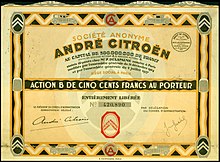
Share for 500 francs of S. A. André Citroën dated 30 September 1927
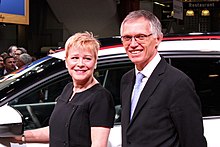
Linda Jackson (former CEO Citroën) and Carlos Tavares (CEO Groupe PSA) at the 2018 Paris Motor Show.
History
Foundation and first assortments
Citroën was founded by André Citroën (1878-1935). The origin of the company's emblem is the double helical gearing (arrow gearing) of gears, the company's first production focus. In 1900, during a trip to Poland, André Citroën acquired a patent for a manufacturing process for a gear cutting machine to produce splines for gears according to an arrangement invented in 1820 by Joseph Woollams (English patent no. 4477 of 20 June 1820).
From 1915 onwards, production was retooled and around 23 million shrapnel shells were manufactured for the First World War. This provided the necessary start-up capital for the first mass-produced European automobile, the Citroën Type A, to roll off the production line after the end of the war in 1919. The electric starter and spare wheel on this vehicle were a special feature at the time.
Developments in the company
- In 1919, production of the first Citroën Type A 10 hp began. At this time the assembly line production was introduced in Europe. The Citroën Type A already had electric lights and an electric starter as standard.
- In 1920 Citroën introduced replacement parts at 300 authorized dealers in France.
- In 1921 Citroën was the first provider of leasing and rental cars.
- In 1921, Citroën erected a total of 165,000 road signs and signposts throughout France with the subtitle " Don de Citroën " 'Donated by Citroën'.
- In 1922, Citroën proved the reliability of the converted Citroën B2 10HP (Kégresse) half-track vehicles by crossing the Sahara via the route from Touggourt and Timbuktu. This expedition was followed by the famous Croisière Noire in 1924 and the Croisière Jaune in 1931 (see below).
- In 1923 Citroën introduced fixed repair prices and Citroën model cars as well as electric or pedal-driven children's cars (Citroënette). Even Citroën scooters (Trotinette) for children of less well-off families were produced.
- In 1924-1925, eight vehicles crossed Africa from Colomb-Béchar to Antananarivo during the Croisière Noire expedition.
- In 1926, Citroën issued Europe's first ten-year bonds.
- In 1926, the first non-French car factory was set up in Belgium in the Brussels commune of Forest/Vorst, which produced for Citroën until 1980.
- In 1927 Citroën was the first company in Europe to introduce the 13th month's salary.
- In 1928 Citroën founded a vocational school.
- In 1929 Citroën gave a one-year guarantee on new cars.
- In 1931, the reliability test and world tour Croisière Jaune took place from Paris to Peking. 35 vehicles set off on a 20,000 km publicity trip.
- In 1933, a Citroën 8 CV Petite Rosalie in Montlhéry drove 136,000 km at an average of 104 km/h in 54 days, setting a world record.
- The first front-wheel-drive Traction Avant, built on a self-supporting all-steel body, left the factory in 1934. Because of its good roadholding, the Traction Avant is said to have been popular with criminals, for example bank robbers, as a getaway vehicle and was therefore also known as the "gangster saloon". Its creators were the constructor André Lefèbvre and the designer Flaminio Bertoni.
Citroën assembly plant Cologne-Poll and Cologne post-war distribution centres
In the 1920s, the Citroën models also had great success in Germany, but this was threatened to end by high tariffs to strengthen the German economy. Individual parts and forged parts were exempt by the so-called milk can tariff. So an assembly plant was built in Germany, which started production in 1927 (before Ford Cologne) and now advertised with Made in Germany. Because of hostility, they also went to using German parts more and more. Until 1935 18,710 vehicles were delivered, furthermore a total of 1,541 commercial vehicles such as omnibuses, platform trucks, articulated lorries, cattle transporters or half-track vehicles such as the Citroën-Kégresse P17. When the Franco-German Trade Agreement was terminated by Germany in 1934 and the main plant in France ran into economic difficulties in 1935, production in Cologne ceased and only repairs were carried out until 1940, when the plant was expropriated for wartime production by Klöckner-Humboldt-Deutz-Werke. The most famous car was the Citroën Traction Avant Six, which was built here in 1934/35.
After the Second World War, Citroën began rebuilding its German distribution in 1950 through a customer service and spare parts centre in Cologne-Sülz (Sülzburgstraße 105) and a sales office opened in the same year in the Belgisches Haus in the Altstadt. A German distribution centre was established in 1952 in Aachener Straße in Lindenthal, and from 1959 to 2013 Citroën Deutschland GmbH moved into its headquarters in Westhoven's Nikolausstraße (later renamed André-Citroën-Straße).
Other facilities in the Citroën era
Citroën opened a company kindergarten, founded and maintained a company orchestra, introduced health insurance and a pension for employees. Schoolchildren learned a great deal about foreign cultures from the goods brought back by the Croisières - the objects were passed around the country's schools as a travelling exhibition.
The world economic crisis, André Citroën's gambler nature and the high development costs for the Traction Avant model brought Citroën into financial difficulties, and bankruptcy had to be filed in 1934. As the largest creditor, the Michelin brothers took over the company. It was thanks to their foresight that the almost fully developed new model was launched on the market.
André Citroën died on 3 July 1935 at the age of only 57. He did not live to see the success of the Traction Avant.
Second World War
Shortly before the Second World War Citroën had some new models in planning and testing:
- Front-wheel drive 8-cylinder prototypes (saloon/convertible) based on the Traction Avant but with a 22-CV engine under the extended bonnet consisting of two 11-CV engines assembled in a V-shape. The prototypes were shipped to Mauritius or Madagascar at the start of the war and have since been lost.
- Light front-wheel drive delivery van, internal designation TUB
- Prototypes of the TPV, the Toute petite voiture, the "very small car". Production began in 1936; after 250 examples it was stopped again because the factory was needed for tank production. Most of the cars were scrapped to avoid falling into the hands of the Germans, but some were just well hidden - three of them (two saloons and a pick-up) so well that they were only rediscovered in 1995 in the attic of an old villa on the former Citroën test site at La Ferté-Vidame in France.
During the war period, the development department worked on making energy sources such as alcohol, gas (wood gas and liquid gas) or electricity usable for vehicle operation in order to compensate for the effects of petrol rationing. Various Citroën vehicles, mainly commercial vehicles, were equipped ex works with Brandt wood gas generators.
Postwar
After the Second World War, the pre-war models were initially continued to be built.
In 1947, the H-type van (later HY, HX, HW, HZ and 1600), which had been further developed from the TUB and was therefore still colloquially called TUB for a long time, was presented, followed a year later on 8 July 1948 by the 2 CV, which had been further developed from the TPV and was also known as the "duck" because of its shape. Internally, the model was again listed as Type A, the van variant as AU, but technically there are no similarities with the pre-war Type A model. In 1955 the model series D (DS, "the goddess") followed, and replaced the Traction Avant, which was still built until 1957. In 1955 Citroën took over a 25 percent share in the French company Panhard.
Flaminio Bertoni's design of the D model series (known as DS) was way ahead of the competition at the time. Asked at the time if this was the car of tomorrow, development manager André Lefèbvre replied: "No, this is a car of today, all the other cars are of yesterday." But it wasn't just the design that was modern, some of the technology was too: the DS introduced hydropneumatic suspension on all wheels via high-pressure central hydraulics. Other technical innovations of the DS were hydraulic power steering and hydraulic brake boosting. This was followed in 1968 by the introduction of cornering lights on the main beam headlamps, as well as the situational automatic height adjustment of both pairs of headlamps (low beam and high beam).
The four-cylinder engine with initially 1900 cm³ displacement and 55 kW (75 hp) was taken over from the 11 CV, only equipped with a new aluminium cross-flow cylinder head. From 1965 there was a newly designed engine series with now 2200 cm³ displacement and 78 kW (104 hp). The DS always had four-cylinder engines. Although 6-cylinder boxer engines were planned and also developed for the DS, these did not fulfill the expectations of the decision makers, why then nevertheless the conventional row engine of the predecessor was fallen back. In order to fit under the flat bonnet, it was pushed as far as possible into the interior under the dashboard, which made a hole in the windscreen frame necessary in order to be able to reach the fourth spark plug.
In 1965 the complete takeover of Panhard followed. Although Citroën did not have a mid-size vehicle in its range, the Panhard 24 was only built for two more years, after which only wheeled tanks were built.
The Ami, Dyane and Méhari appeared in the small car and lower mid-size segment, and a mid-size GS was introduced in 1970. Citroën built trucks, bought Maserati - which gave rise to the SM upper-class sports coupé - and built a GS version with a Wankel engine. The oil crisis put a rude end to these expensive experiments and Citroën faced bankruptcy in 1974. Michelin, the majority shareholder, tried to sell parts to Fiat. The commercial vehicle division was sold to Renault, Maserati to de Tomaso.
The PSA era
In 1975, the until then competing Peugeot S.A. took over Citroën S.A. as its subsidiary. Since then, the partially listed Peugeot S.A. has operated as a holding company under the group brand PSA Peugeot Citroën (PSA for short), under which all models of the group brands are developed on common platforms.
The last Citroën model before the merger was the CX, the first joint models were the Visa and the LN, which shared the technical basis with the Peugeot 104. The LN also had the body of the 104 Z, while the design of the Visa body went back to a Citroën design from pre-PSA times, but could not be realized due to the shared platform.
The original Visa was later built in Romania by the Oltcit joint venture and exported to Western Europe as the Citroën Axel, but no two parts of the two visually very similar models were the same. The French-built engines of the two-door Oltcit were the air-cooled 4-cylinder boxer engines of the larger GS model. The Visa had the slightly enlarged and somewhat modified 2-cylinder air-cooled boxer engine of the Citroën 2 CV with 652 cc (while the 2 CV had maximum 602 cc engines) or, as Visa II, water-cooled Peugeot engines. Analogously, the same engines were also available in the LN, which - equipped with the water-cooled 4-cylinder in-line engines - was offered as LNA.
In October 2005, Citroën announced its intention to cooperate with the gas supplier GDF Gaz de France in the natural gas car market and to offer vehicles in the Toulouse area that can be self-fuelled from a gas connection at home from 2007 onwards. The 500 euro compressor required for this would be provided free of charge.
At the end of 2013, rumors circulated that Citroën wanted to abandon the hydropneumatic suspension, which even prompted Citroën fans to petition the manufacturer. At the 2014 Geneva International Motor Show, the new C5 Crosstourer was unveiled as "currently the only hydropneumatic model". The last Citroën with hydropneumatics was produced in August 2017.
The DS3/Cabrio, DS4 and DS5 models had already been offered under the premium Citroën DS label since 2010. In June 2014, the premium sub-brand DS Automobiles (DS for short) was then established and the first DS models DS 5LS and DS 6WR were marketed exclusively in China. In 2015, the spin-off of Citroën DS models to the DS sub-brand also began in Europe, starting with the redesign of the Citroën DS5 (with the Citroën double angle in the grille) to the DS 5 (with the brand logo called DS Wings). Coinciding with the facelift of the Citroën DS4 to the DS 4, the DS 4 Crossback was also released. The DS model range at this time included a range from small cars to a compact coupe to a mid-size sportbrake coupe; a folding-roof convertible (DS 3 Cabrio) is also in the range.
Other
Citroën has been the main shirt sponsor of the Spanish first division football team Celta Vigo since the beginning of the 21st century.
The company's archive is called the Conservatoire CITROËN and is used for scientific work related to the company's history. A touristic visit is only possible to a limited extent.

So far the last model of the upper middle class: the C6
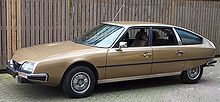
The top model from 1974 to 1989: the CX
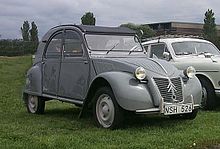
A new start after the war: the 2 CV, popularly known as the "duck".
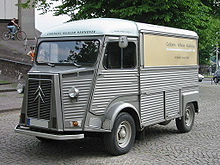
Citroën HY , built from 1947 to 1981
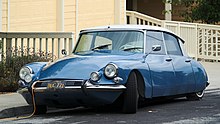
"The Goddess": Citroën DS
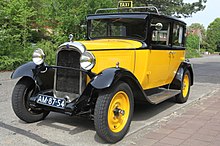
Citroën C4 Taxi
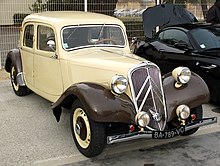
Citroën Traction Avant
Citroën models
Passenger car
1919 to 1945
- Citroën Type A (1919-1921)
- Citroën Type B2 (1921-1926)
- Citroën Type C (1922-1926)
- Citroën type B10 (1924-1925)
- Citroën Type B12 (1925-1927)
- Citroën Type B14 (1926-1928)
- Citroën C4 (1928-1932)
- Citroën C6 (1928-1932)
- Citroën Rosalie 8 CV, 10 CV, 15 CV (1932-1938)
- Citroën Traction Avant (1934-1957)
- Citroën 7 CV
- Citroën 11 CV
- Citroën 15 CV (6-cylinder)
- Citroën 22 CV (8-cylinder prototype, 1939)
· 
Citroën Type A (1919-1921)
·
Citroën Type B12 (1925-1927)
· 
Citroën Traction Avant (1934-1957)
1945 to 1975
- Citroën 2 CV Duck (1949-1990)
- Citroën D models: DS (" La Déesse " 'The Goddess') (1955-1975), ID (Idée) (1957-1975), as well as D Spézial and D Super/D Super 5
- Citroën Bijou (1959-1964)
- Citroën Ami 6 (1961-1969)
- Citroën Dyane (1967-1984)
- Citroën Méhari (1968-1987)
- Citroën Ami 8 (1969-1978); including Ami Super (1973-1976)
- Citroën M35 (1969-1971)
- Citroën SM Sa Majesté (1970-1975)
- Citroën GS (1970-1979; 1979-1986: GSA)
- Citroën GS Birotor (1973-1975; models with Wankel engines, see also Comotor and NSU)
- Citroën CX (1974-1991)
- Citroën Pony (1975-1982)
· 
Citroën Ami 6 (1961-1969)
· 
Citroën SM (1970-1975)
· 
Citroën GS (1970-1979)
Since 1975 (Citroën under PSA)
- Citroën LN Hélène (1976-1986, from 1978 LNA; identical in construction to Peugeot 104 Z, similar to Talbot Samba)
- Citroën Visa (1978-1988, on the platform of the Peugeot 104)
- Citroën A4x4 (1979-1983; 5000 units)
- Citroën BX (1982-1994)
- Citroën Axel (1984-1988; was already manufactured in Romania from 1981 as Oltcit)
- Citroën AX (1986-1998)
- Citroën XM (1989-2000, similar to Peugeot 605)
- Citroën ZX (1991-1998, similar to Peugeot 306)
- Citroën Xantia (1992-2001, similar to Peugeot 406)
- Citroën Evasion (1994-2002, identical in construction to Fiat Ulysse, Lancia Zeta and Peugeot 806)
- Citroën Saxo (1996-2003, similar to Peugeot 106)
- Citroën Berlingo (since 1996, identical in construction to Peugeot Rifter)
- Citroën Xsara (1997-2006, similar to Peugeot 306)
- Citroën Xsara Picasso (1999-2010)
- Citroën C5 (2001-2017)
- Citroën C3 (since 2002)
- Citroën C8 (2002-2014, identical in construction to Eurovans)
- Citroën C2 (2003-2009)
- Citroën C3 Pluriel (2003-2010)
- Citroën C4 (2004-2018, from 2020)
- Citroën C1 (since 2005, identical in construction to Peugeot 107/108 and Toyota Aygo)
- Citroën C6 (2005-2012)
- Citroën C4 Picasso (since 2006)
- Citroën C-Crosser (2007-2013)
- Citroën C3 Picasso (2009-2017)
- Citroën C4 Aircross (2012-2017)
- Citroën C4 Cactus (2014-2020)
- Citroën C3 Aircross (since 2017)
- Citroën C5 Aircross (since 2017)
- Citroën Ami (since 2020)
- Citroën C5 X (since 2021)
· 
Citroën BX (1982-1994)
· 
Citroën Berlingo (since 1996)
· 
Citroën C5 Aircross (since 2017)
Since 2014 (DS Automobiles under Citroën)
- DS3 (2010 to 2015 as Citroën DS3)
- DS 4 (2011 to 2015 as Citroën DS4)
- DS 5 (2011 to 2015 as Citroën DS5)
→ Main article: DS Automobiles
Only on the Chinese market
- DS 5LS (since 2014)
- DS 6WR (since 2014)
Commercial Vehicles
Pre-war era (until 1945)
- Tractors
- Kegresse tracked vehicles
- Citroen W 15 T
- Citroën Type A Pick-up and Omnibus (1919-1921)
- Citroën type B2 pick-up and omnibus (1921-1926)
- Citroën type B12 pick-up, omnibus and panel van (1925-1927)
- Citroën type B14 pick-up, omnibus and panel van (1926-1928)
- Citroën Type B15 Citroën's first truck also as omnibus (1926-1928)
- C4 pick-up, omnibus and panel van (1928-1932)
- Citroën Rosalie pick-up, omnibus and panel van (1932-1938)
- Citroën type 29 truck and bus successor of the type B15 (1933-1934)
- Citroën type 45 truck and bus (1933-1953)
- Citroën Traction Avant pick-up and panel van (1934-1957)
- Citroën Type 32 truck and bus replaced the Type 29 with higher payload (1934-1948)
- Citroën type 23 truck and bus (1935-1969)
- TUB van and minibus (1939-1941)
Post-war era (1945 to 1975)
- H, HY, HW, HX, HZ and 1600 Le TUB (1947-1981); originally planned as a replacement for the Citroën Type 32
- AU, AZU, AK, AKS box duck (1951-1978; 2 CV as box car)
- Citroën Type 55 (1953-1965); successor of the Type 45
- Citroën Belphégor (1965-1972); successor of type 55/type 23
- Citroën-Berliet K (1970-1974); successor to the Belphégor. The takeover of Berliet was intended to create a model that was simpler in production. The K received a driver's cab from Berliet, but kept the chassis of the Belphégor. Due to the sale of Berliet to Renault, the production was already stopped at the end of 1974.
- Citroën C35 (1974-1991; identical in construction with Fiat 242)
PSA era (from 1975)
- Citroën Acadiane (1978-1987; Dyane as panel van)
- Citroën C25 (1981-1993; identical in construction to Fiat Ducato and Peugeot J5)
- Citroën C15 (1984-2005; Visa as panel van)
- Citroën Jumper (1994-2006; identical in construction to Fiat Ducato II and Peugeot Boxer)
- Citroën Jumpy (1995-2006; identical in construction to Fiat Scudo and Peugeot Expert)
- Citroën Berlingo (since 1996, identical in construction to Peugeot Partner)
- Citroën Jumpy II (2007-2016; identical in construction to Fiat Scudo II, Peugeot Expert II and Toyota Proace)
- Citroën Jumper II (since 2007; identical in construction to Fiat Ducato III and Peugeot Boxer II)
- Citroën Nemo (since 2008; identical in construction to Fiat Fiorino and Peugeot Bipper)
- Citroën Jumpy III (since 2016; identical in construction to Peugeot Expert III, Toyota Proace II and Opel Zafira Life)
· 
Citroën Type H (1947-1981)
· .jpg)
Citroën Acadiane (1978-1987)
·
Citroën Jumper (since 1994)
Timeline
| Timeline of Citroën and DS models since 1945 |
| ||||||||
| Type | until 1975 Michelin era | Bought by Peugeot in 1975 and thus part of PSA |
| ||||||
| 1940s | 1950s | 1960s | 1970s | 1980s | 1990s | 2000s | 2010s 2020s | ||
| 5 | 6 | 7 | 8 | 9 | 0 | 1 | 2 | 3 | 4 | 5 | 6 | 7 | 8 | 9 | 0 | 1 | 2 | 3 | 4 | 5 | 6 | 7 | 8 | 9 | 0 | 1 | 2 | 3 | 4 | 5 | 6 | 7 | 8 | 9 | 0 | 1 | 2 | 3 | 4 | 5 | 6 | 7 | 8 | 9 | 0 | 1 | 2 | 3 | 4 | 5 | 6 | 7 | 8 | 9 | 0 | 1 | 2 | 3 | 4 | 5 | 67 8 9 0 1 2 3 4 5 6 7 8 9 0 1 | |
| Small and very small cars | Ami | |||||||||||||||||||||||||||||||||||||||||||||||||||||||||||||
| 2CV | C-ZERO | |||||||||||||||||||||||||||||||||||||||||||||||||||||||||||||
| LN | LNA | AX | Saxo | C1 | C1 II | |||||||||||||||||||||||||||||||||||||||||||||||||||||||||
| Ami 6 | Ami 8 | Visas | C2 | DS3 | ||||||||||||||||||||||||||||||||||||||||||||||||||||||||||
| Dyane | Axel | C3 | C3 II C3 III | |||||||||||||||||||||||||||||||||||||||||||||||||||||||||||
| Compact class | GS | GSA | ZX | Xsara | C4 | C4 II C4 III | ||||||||||||||||||||||||||||||||||||||||||||||||||||||||
| DS4 DS4 | ||||||||||||||||||||||||||||||||||||||||||||||||||||||||||||||
| DS4 S | ||||||||||||||||||||||||||||||||||||||||||||||||||||||||||||||
| Elysée | C Elysée | |||||||||||||||||||||||||||||||||||||||||||||||||||||||||||||
| Middle class to upper class | BX | Xantia | C5 | C5 II C5 III C5 X | ||||||||||||||||||||||||||||||||||||||||||||||||||||||||||
| Traction Avant | DS | CX | XM | DS5 | ||||||||||||||||||||||||||||||||||||||||||||||||||||||||||
| DS 5LS | ||||||||||||||||||||||||||||||||||||||||||||||||||||||||||||||
| SM | C6 | C6 II | ||||||||||||||||||||||||||||||||||||||||||||||||||||||||||||
| DS9 | ||||||||||||||||||||||||||||||||||||||||||||||||||||||||||||||
| Compact van | Xsara Picasso | C3 Picasso | ||||||||||||||||||||||||||||||||||||||||||||||||||||||||||||
| C4 Picasso C4 Picasso II | ||||||||||||||||||||||||||||||||||||||||||||||||||||||||||||||
| Van | Evasion | C8 | ||||||||||||||||||||||||||||||||||||||||||||||||||||||||||||
| Beach Car | Méhari | C3 Pluriel | e-Méhari | |||||||||||||||||||||||||||||||||||||||||||||||||||||||||||
| Pony | ||||||||||||||||||||||||||||||||||||||||||||||||||||||||||||||
| SUV | C3-XR | |||||||||||||||||||||||||||||||||||||||||||||||||||||||||||||
| C3 Aircross C3 Aircross II | ||||||||||||||||||||||||||||||||||||||||||||||||||||||||||||||
| DS 3 Crossback | ||||||||||||||||||||||||||||||||||||||||||||||||||||||||||||||
| C4 Cactus C4 Cactus II | ||||||||||||||||||||||||||||||||||||||||||||||||||||||||||||||
| C-Crosser C4 Aircross C4 Aircross II | ||||||||||||||||||||||||||||||||||||||||||||||||||||||||||||||
| C5 Aircross | ||||||||||||||||||||||||||||||||||||||||||||||||||||||||||||||
| DS6 | ||||||||||||||||||||||||||||||||||||||||||||||||||||||||||||||
| DS 7 Crossback | ||||||||||||||||||||||||||||||||||||||||||||||||||||||||||||||
| High roof station wagon | 2CV van | Acadiane | C15 | Nemo | ||||||||||||||||||||||||||||||||||||||||||||||||||||||||||
| Berlingo I | Berlingo II Berlingo III | |||||||||||||||||||||||||||||||||||||||||||||||||||||||||||||
| Van | C35 | Jumpy | Jumpy II Spacetourer | |||||||||||||||||||||||||||||||||||||||||||||||||||||||||||
| Type H | C25 | Jumper | Jumper II | |||||||||||||||||||||||||||||||||||||||||||||||||||||||||||
| Citroën DS, from 2009 sub-brand of Citroën, from June 2014 own brand within PSA. Models from 2010 as sub-brand, from 2014/2015 without Citroën reference. Together with the Fiat group - as Citroën, Fiat (and possibly Peugeot, Lancia or Talbot) From Namco Motors Together with Toyota Based on a Mitsubishi | ||||||||||||||||||||||||||||||||||||||||||||||||||||||||||||||
Search within the encyclopedia

